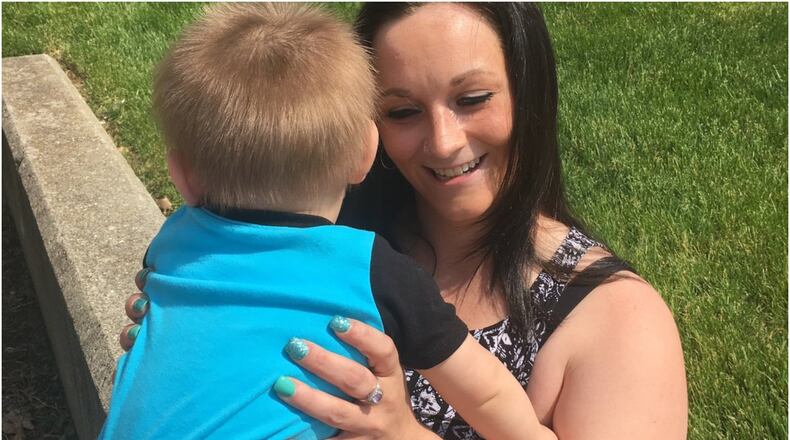Heroin addiction is “the biggest single challenge that we have,” Morrison said. “It’s alarming because it’s the number of kids in our population and we’re having to address those families.”
There were about 13,700 children in care last year, up from about 12,400 in 2012, according to the Public Children’s Services Association of Ohio’s (PCSAO) annual fact book released earlier this month.
In 2015, 28 percent of children taken into custody had parents using opioids, according to the survey.
“We’re very fearful we’re going to lose an entire generation if we don’t as a state step up appropriately and adequately meet their needs,” Executive Director Angela Sausser said.
Morrison said crack cocaine had a similar impact on the welfare of children years ago. But heroin, he said, is different. It changes a parent.
“The thing that is unique about heroin is that the level of addiction is so extraordinary that the person will reach a point where it’s the only thing that matters,” he said. “In order to continue to get the fix, there really are a lot of dangerous behaviors that people will engage in.”
Many children have been trained to use Narcan by their parents, Sausser said, while in other situations, young girls have been prostituted so parents get purchase drugs. In one situation, a son watched his father beat his mother until she agreed to purchase drugs, she said.
“These are the situations these kids are coming from,” Sausser said. “That type of trauma impacts their mental health and their development. They need a lot of help. If we don’t address it now, these young children are going to grow up with a lot of issues.”
Growing costs
The state currently spends about $1 billion annually in child protection services, Sausser said. The state provides about $45 million to Ohio counties, or about five percent of the overall expenditures, she said. The remaining money comes from federal funding and local children’s services levies, Sausser said.
Butler County spends about $26 million on children’s services, including about $13 million in local levy money. A renewal of the 2-mill Butler County Children’s Services levy will go before voters in November.
RELATED: 7 items that top Butler County’s 2017 to-do list
Due to the growth of children in care and the rising costs of placements, counties aren’t able to pay for services solely with levy money, Sausser said.
The PCSAO was asking state legislators to increase its child protection allocation by $30 million annually in the ongoing biennial budget process, Sausser said.
The recently approved Ohio House of Representatives budget increased the total amount by $15 million annually, Sausser said. The Ohio Senate held budget hearings last week where child protection services providers testified to maintain and increase the funding, she said. The state budget is expected to be signed at the end of June.
The rise in opioid-related cases is significantly taxing the system, Sausser said. About 19 percent of children are staying in foster care longer because of the amount of time it takes for parents to successfully recover, she said.
That’s made it difficult for counties to find available foster homes, Sausser said. There are about 14,000 children in foster care this year and there are about 7,000 licensed foster homes, she said.
“Many of these foster parents are caring for kids who aren’t able to go back home because their parents are still addicted to drugs,” Sausser said. “Many of these parents are moving towards adopting these kids. When that happens, it puts a strain on our system in terms of being able to find an available home for the child.”
Due to the amount of trauma, some child will be admitted to a higher level of care, such as a residential treatment facility, rather than a foster home or kinship family, she said.
Butler County’s approach: Engage early
Morrison and Julie Gilbert, assistant director of Butler County Children Services, said Butler County has seen some success because social workers “engage” with addicted parents early. They said the sooner an addict can seek treatment, the more likely for a recovery.
The goal: Keep children with stable relatives or friends until their parents are clean and sober.
“We don’t take away their hope,” Morrison said of addicts who are parents. “That’s a big part of it. In order for people to be motivated to change, they have to believe that change is going to work. That there is a way out of the problem. I don’t think there is anybody using heroin that’s glad to be using heroin.”
RELATED: Opiate epidemic focus of new Butler County Family Drug Court
Butler County Children Services has $500,000 built into its budget to pay for room and board for parents at Sojourner Recovery Services, an alcohol and drug addiction treatment and mental health service provider.
Medicare pays for treatment, Morrison said.
“When we have engagement by families, parents engage in services, and we are collaborating with providers that leads to positive outcomes and reunification,” Gilbert said.
Gilbert, a mother herself, said she doesn’t understand why anybody, a parent or not, would try heroin.
“I think what’s difficult for our case workers this addiction takes over and nobody wants to be a heroin addict,” she said. “And they come in and say, ‘I really want to change. I want to get treatment. I want to get well for my kids.’ But it’s so powerful that even with treatment you see they are not successful.”
Julie Payton, senior director of Addiction Services at the Butler County Mental Health and Addiction Recovery Services Board, said the “power of addiction” becomes the first and foremost in the minds of addicts and takes over everything they truly love and value.
“They feel compelled to feed that addiction,” she said.
Even at the expense of feeding their children, Payton said.
“This is extremely sad,” she said.
This year, the Journal-News has reported cases where children have found parents unresponsive, including the most recent last week: A 5-year-old Middletown boy who walked two blocks to his step-grandfather’s house at about 5 a.m. to say his parents were dead, according to Middletown police.
Officers found Chelsie Marshall, 24, and Lee Johnson, 25, overdosed on heroin. A 3-month-old girl was also found in the home, crying in a car seat in the living room, according to the police report.
Trickling down to the younger population
Rob Clevenger, Butler County Juvenile Court administrator, said after reviewing the 362 cases filed from last year, drugs were involved by the custodian of the juveniles 194 times, or 54 percent.
Of those where drugs were determined, 71 percent were for heroin/opioids, 12 percent meth, 7 percent cocaine and 10 percent other drugs, he said.
Clevenger said another trend is concerning to his department. People are experimenting with heroin at an earlier age.
Just two to three years ago, of the 1,500 juveniles served in the detention center, 10 of them had heroin as part of their profile.
Recently, during one day, of the 45 juveniles in the center, five were involved with heroin, he said.
“It was inevitable that it trickled down to the juvenile population,” he said.
That trend, he said, should be “a significant concern to our community.”
Addicted parents often are too busy getting high or trying to score drugs to meet the physical and emotional needs of their offspring, experts said. Children of addicts can end up malnourished, physically abused and traumatized.
Robert Haley, regional director for CHOICES, a treatment center that recently opened in Middletown, agreed. He said heroin “destroys the family dynamic” and re-adjusts a parent’s priorities.
“Their whole behavior is going to be different,” Haley said. “That person will withdraw from society.”
Hamilton mother fighting for a comeback
During a time when the “heroin epidemic” is spiraling in Butler County, one Hamilton woman, a recovering heroin addict, offers some hope.
Megan Franken, 26, who has been addicted to heroin for the past seven years, was granted legal custody of her 13-month-old son this week. The single mother, who twice has lost custody of her son due to her drug addiction, said she’s done with heroin now and forever.
Franken, once a college student studying to be a nurse, has overdosed and been revived by Narcan three times.
“I didn’t care,” she said of her addiction.
That was Franken before.
She’s a changed woman, she said. She has surrounded herself with a lot of “sober, positive people,” including her father and sponsor at Narcotics Anonymous meetings, she said.
“I love life,” said Franken, who lives at Sojourner Recovery Services Motherhood and Maternity Addiction Services (MAMAS) house. “I love my son. I want it this time. I want to be the best mom I can be.”
A 2009 graduate of Northwest High School in Cincinnati, Franken said her mother was addicted to pain pills and alcohol and died in 2010. She was 39. One of her brothers recently was arrested for heroin possession, she said.
“It’s time to end this cycle,” she said.
Now, Franken said, her next step is enrolling back in college. She hopes to take on-line courses at the University of Phoenix and became a counselor.
“If I can help someone where I used to be, that’s what I want to do,” she said.
As Franken told her tale, Amy Miller, who supervises Franken’s case, listened intently. A smile crossed her face.
“When I hear her story, it gives us hope that there are families that can get through heroin and succeed,” Miller said. “She is one of those examples that when we all work together and the resources are there, there can be success.”


